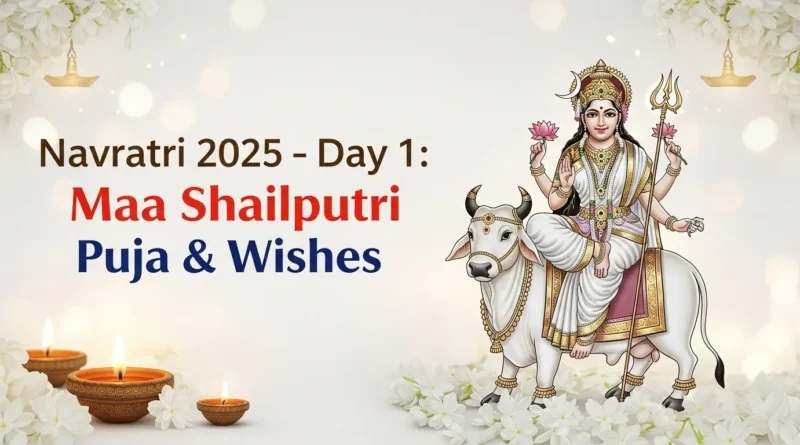Navratri 2025 Day 1: Significance of Maa Shailputri, Colour, Rituals and Wishes
Table of Contents
Introduction
The countdown is over—Sharad Navratri 2025 begins on 22 September, marking the start of nine days of devotion, fasting, and celebration across India. Day 1 of Navratri, also known as Pratipada, is dedicated to Maa Shailputri, the first form of Goddess Durga.
From early morning rituals like Ghatasthapana (Kalash Sthapana) to vibrant colour traditions and heartfelt wishes, the first day of Navratri sets the tone for the entire festival. This year, devotees will dress in white, offer prayers, and share blessings for peace, purity, and strength. Here’s everything you need to know about Navratri Day 1, including rituals, colours, goddess significance, and inspiring messages to share with family and friends.
Maa Shailputri: The First Day Goddess
Navratri begins with the worship of Maa Shailputri, also known as the “daughter of the mountains.” The name is derived from Sanskrit—Shaila meaning mountain, and Putri meaning daughter. She is depicted riding Nandi the bull, holding a lotus in one hand and a trident in the other, with a crescent moon on her forehead.
Maa Shailputri is considered the embodiment of purity and devotion. She symbolizes stability and strength, much like the mountains she represents. Worshipping her on Day 1 is believed to purify the mind, invite inner calm, and lay a strong spiritual foundation for the next eight days of Navratri.
Her story traces back to a previous birth as Goddess Sati, who self-immolated to defend her husband Lord Shiva’s honour. Reborn as Parvati—the daughter of King Himavan, the lord of the Himalayas—she is venerated as Shailputri. This makes her the starting point of the Navadurga worship cycle.
Rituals and Ghatasthapana
The first day of Navratri is also marked by Ghatasthapana, or Kalash Sthapana, an essential ritual symbolizing the presence of divine energy in the home. Devotees place a decorated Kalash (sacred pot) filled with water, mango leaves, and topped with a coconut. This pot is placed on a bed of soil in which barley seeds are sown, representing growth, fertility, and prosperity.
Puja vidhi on this day includes chanting Maa Shailputri’s mantras, offering flowers, lighting diyas, and presenting a special bhog (food offering). White flowers, milk, coconut preparations, and sattvic food items like sabudana are commonly offered to please the goddess.
Fasting is another central aspect. While some devotees observe a full fast, others consume fruits, milk, or light vegetarian meals throughout the nine days.
Colour of the Day: White
Each day of Navratri is associated with a specific colour, and for Day 1 in 2025, it is white. White stands for peace, purity, and simplicity. Wearing white during Shailputri puja is believed to bring serenity and positive energy.
Many devotees also decorate their homes with white flowers like jasmine and create rangolis or puja setups with white themes. Even the bhog items—often made from milk or coconut—reflect the colour of the day.
For social media posts, WhatsApp statuses, and festive images, incorporating white backgrounds and goddess Shailputri’s symbolism has become a growing trend.
Navratri 2025 Day 1 Wishes, Quotes, and Messages
The first day of Navratri is also a time to share positivity and blessings with loved ones. Here are some wishes and messages aligned with the spirit of Maa Shailputri:
- “May Maa Shailputri bless your home with peace, purity, and prosperity on this first day of Navratri.”
- “On the first day of Navratri, let’s embrace white—the colour of serenity—and seek the blessings of Goddess Shailputri.”
- “Happy Navratri 2025! May the divine energy of Maa Shailputri fill your life with strength and devotion.”
- “Wishing you a blessed start to Navratri. May the purity of Maa Shailputri guide you towards a path of happiness.”
These quotes and messages can be used as WhatsApp statuses, Instagram captions, or greeting card notes to connect spiritually while celebrating culturally.
The Broader Significance of Day 1
The first day of Navratri is not just about beginning rituals—it’s about setting intentions for the entire nine-day journey. Worshipping Maa Shailputri is symbolic of grounding oneself, just as mountains stand firm. It reminds devotees to start afresh with humility, patience, and discipline.
By aligning with the colour of the day and performing traditional puja, believers seek balance between material life and spiritual growth. The practices of fasting, offering white foods, and maintaining purity in thoughts and actions all tie back to the essence of Shailputri—simplicity, peace, and devotion.
Conclusion
As Navratri 2025 begins on 22 September, Day 1 devoted to Maa Shailputri sets the festive and spiritual rhythm for the days ahead. From Ghatasthapana rituals and wearing white to offering sattvic bhog and sharing heartfelt Navratri wishes, every element carries deep significance.
In an era where traditions are often celebrated both offline and online, the first day of Navratri offers a perfect opportunity to blend devotion with modern expressions—through puja at home, festive attire, and even digital wishes on social media.
May Maa Shailputri bring peace, stability, and prosperity to all devotees as we step into this nine-day journey of faith and celebration.

